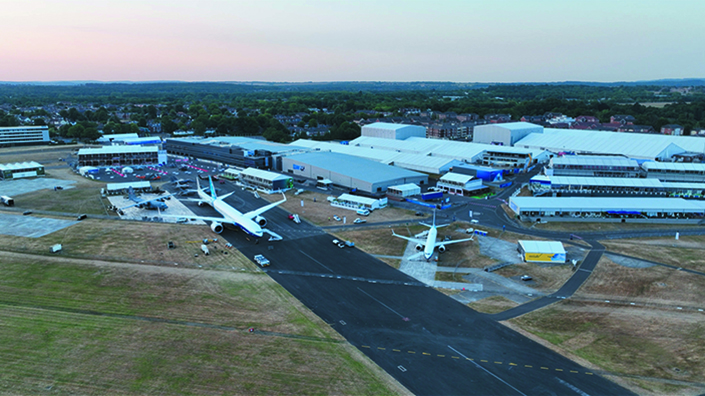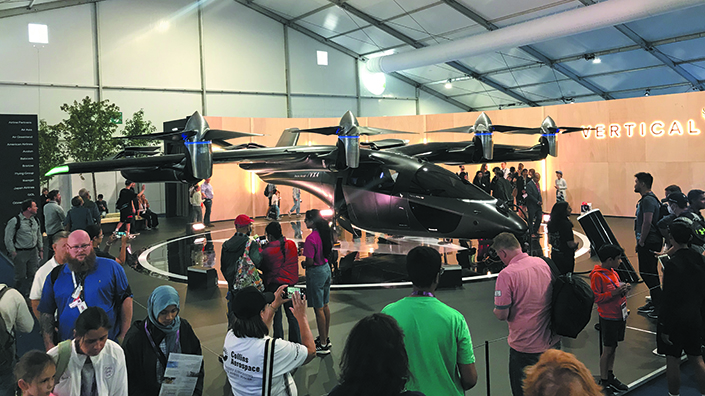High-Mach projects take shape
If commercial supersonic flight does return to the skies, chances are it will look something like the Overture. Prospective Concorde successor Boom Supersonic unveiled a ‘refined’ design for its supersonic airliner, designed to fly at up to Mach 1.7 over water and Mach 0.94 over land. Based on 26 million hours of simulation, the 65-80-passenger aircraft now includes four engines rather than two, which Boom says will reduce noise and decrease costs for airlines when Overture starts flying later this decade.
Hypersonic passenger flight is unlikely to take off any time soon, but military investment in Mach 5+ technology is increasing following Russia’s invasion of Ukraine. The biggest hypersonic announcement during the airshow came from propulsion experts Reaction Engines, Rolls-Royce, the Royal Air Force, the Defence Science and Technology Laboratory and the National Security Strategic Investment Fund, which revealed plans to collaborate on a reusable hypersonic aircraft to provide ‘significant enhancements’ to the UK’s defence capabilities.
Reaction Engines CEO Mark Thomas told Professional Engineering: “Big amounts of money are being spent to pursue hypersonic technologies, but most of them are aimed at devices that are on a one-way trip. What we’re exploring is something different, which is a reusable asset designed to go off, do a job, come back, and be used over and over again – but also making sure it’s sufficiently low-cost that you can have a fleet of these systems.”
The Hypersonic Air Vehicle Experimental (HVX) programme clearly has no lack of ambition, but its aims present some considerable challenges. Air temperatures reach more than 1,000ºC at speeds of Mach 5 and above, and that stress will quickly build up on the engine and airframe over multiple flights. Thankfully, Thomas said the project partners have the precise expertise needed to overcome such hurdles. “Reaction Engines has the propulsion system engineering knowledge,” he said. “Rolls-Royce has been doing gas turbines for many decades so they’ve got incredible capability. But we also bring the cooling technology – that’s the absolute key.”
Initially designed for the Sabre spaceplane engine, Reaction’s precooler uses thousands of thin-walled tubes filled with helium to rapidly absorb heat from incoming airflow, cooling 1,000ºC+ air in less than 1/20th of a second.
Reaction presented a ‘hypothetical’ concept vehicle at Farnborough, but Thomas insisted that the project will achieve its objectives “very rapidly,” helped in part by the firm’s fast-paced, experimental culture and private-company ethos. The vehicle design will be refined over the next 12-18 months, followed by engine testing and flight trials.
Sustainable change needed

Searing temperatures and scorched grass highlighted the vital importance of low-carbon aviation
On the second day of the airshow, the UK baked in its hottest ever temperatures. There was huge disruption around the country as the mercury topped 40ºC, including airports closing because of melted runways. There could no longer be any doubt – the aerospace sector must become more sustainable, and it must do so now.
“Aviation is only 2-3% of mankind’s total carbon footprint,” said Dr Guy Gratton, associate professor of aviation and the environment at Cranfield University, pilot and programme manager for the Enabling Aircraft Electrification (Enabel) project, and IMechE fellow.
“However, whilst every other industry is successfully decarbonising, the reality – if you ignore the glitch that is Covid – of air transport is that it has been reducing its per-passenger mile carbon footprint by about 2% year-on-year, but it’s been growing by about 5% year-on-year, the 3% difference being our fundamental problem.
“So there is a real risk we will outgrow everybody else’s carbon reductions and end up the world’s largest emitter, which we are keen as an industry not to do.”
With destructive climate change already here, and Covid showing that many flights are unnecessary, the sector’s sustainability drive cannot rest solely on the shoulders of engineers. Sales of commercial planes showed little sign of a substantial slowdown, however. According to AeroTime Hub there were 282 firm orders, down from 400 in 2018 but not far below the 335 orders in 2016.
Hydrogen propulsion flies closer
Sustainable flight options could arrive sooner than expected thanks to the development of key technologies, GKN Aerospace claimed on the second day of the airshow.
Hyperconducting systems proposed by the West Midlands company would use onboard liquid hydrogen as a heat sink, cooling electrical conductors to less than -200°C to dramatically reduce their electrical resistivity. This reduction in resistivity would enable electrical power distribution at low voltage, lower-mass conducting cables, and electric motors with over 99% efficiency, GKN claimed, helping enable rapid scaling of hydrogen-electric flight from 19 or 48 passengers to 96 and beyond.
Hydrogen flight is already well under way at British-American firm ZeroAvia, which plans to bring a 9-19-seat aircraft into service in 2024. Speaking at the airshow, hydrogen CTO Rudolf Coertze said the company was on the cusp of trials using its new flying testbed with that capacity, a modified Dornier 228.
Those test flights will follow an earlier programme using a modified two-seater Piper Malibu Mirage, which provided a first insight into hydrogen fuel-cell-powered flight. The flights from Cranfield Airport in Bedfordshire “really demonstrated the feasibility of fuel-cell technology for flight,” said Coertze. “We have learnt a lot from that – we have implemented those learnings already into the testbed that we are going to fly now.”
The modified Piper crashed during testing on 29 April 2021 after power to the electrical motors was lost when onboard batteries were switched off, with the intention of handing over to the fuel cells. The windmilling propeller generated a voltage high enough to operate the inverter protection system, an Air Accidents Investigation Branch report found, locking out power to the motors.
“While the report does not make specific recommendations for ZeroAvia within its conclusions, many of the issues identified in the report were similarly noted in our internal investigation and have been addressed robustly,” said a company statement. Changes included the establishment of a safety and security review board, and a safety management system based on a ‘just culture,’ including occurrence reporting, investigation and corrective actions.
Takeaways from the initial test programme included a focus on validation of simulation to understand flight behaviours, such as effects of altitude, and integration of the hydrogen and electric propulsion systems, said Coertze.
Unlike the earlier testbed, commercial hydrogen-powered aircraft will not include battery packs. “The energy density of batteries is quite a big disadvantage for flight, this is where hydrogen-electric powerplants give you a big advantage in terms of overall energy density. In the end, hydrogen-electric is still the only one that really gives us the cleanest solution.”
Horizontal satellite launch
US Air Force C-17s have been safely airdropping troops, supplies and vehicles around the world for decades. What if they could launch satellites into orbit as well?
That is the plan at British-American commercial space launch company Astraius, which aims to avoid the challenges of conventional vertical launch by instead loading smaller launch vehicles into the back of C-17s. After launching from Prestwick Airport in Glasgow and reaching the optimal altitude and position, the rear cargo doors would open and ‘drogue’ parachutes would deploy from the pallet holding the rocket. Extraction chutes would follow, pulling the pallet out of the plane, before further chutes slow its fall and correct its orientation. The launch vehicle would then separate and ignite its solid rocket motor in the first stage, heading towards orbit.
The system will have a payload capacity of 800kg to low Earth orbit or 380kg to Sun-synchronous orbit – more than horizontal launch pioneer Virgin Orbit, which has capacity for 300kg and 500kg respectively.
Unlike Virgin Orbit, Astraius launches will not need a modified carrier aircraft. The company instead plans to lease C-17s and crew from the USAF, avoiding purchase and operations costs.
Similar missions have already launched rockets to exercise satellite defence systems, so Astraius is confident in its approach. “Airdrop via parachute has been occurring for decades on a variety of platforms,” said CTO Shane Clark. “This method that we’re using for Astraius is something that the US government has been using for dozens of years.”
Flying taxis prepare for take-off

The life-size model of the Vertical Aerospace VX4 flying taxi
After years of hype, eVTOLs – commonly referred to as flying taxis – also appeared closer to take-off. Bristol firm Vertical Aerospace, which has more than 1,000 pre-orders, wowed the Farnborough crowds with a life-size model of its electric VX4 aircraft – but a real 1:1 aircraft was also nearing a summer test flight campaign.
The company is also part of the Future Flight Challenge, run by UK Research and Innovation and involving partners including Virgin Atlantic, Atkins, infrastructure developer Skyports, and Warwick Manufacturing Group at the University of Warwick. The two-year project will cover aspects such as drone flights, charging technology and software protocols, and will include two VX4 flights, between Bristol Airport and an airfield in South West England, and Heathrow airport and a new Skyports ‘vertiport’.
“The focus of the project really is to demonstrate that the UK has all of the constituent pieces to allow advanced air mobility to take off and flourish in both an urban and a regional environment,” said Dominic Jackson, market development manager at Vertical Aerospace.
“There are no fundamental technologies that need to be developed in the next couple of years before we fly,” he said. “A lot of the technology we use is already off-the-shelf… you’re never going to be able to go to the Civil Aviation Authority with an experimental, R&D, lab-based technology and then expect that you’ll be able to deploy that in civil aviation within a three-year timeframe.”
Underlying technologies include battery cells from Molicel in Taiwan, engines, electric motors and inverters from Rolls-Royce, and wings and fuselage developed with GKN and Leonardo respectively. The main challenge now, said Jackson, is integration and certification.
This article appears in Professional Engineering magazine, Issue 5 2022.
Become a net zero expert at Sustainability in Engineering (26-30 September), part of the Engineering Futures webinar series. Register for FREE now.
Content published by Professional Engineering does not necessarily represent the views of the Institution of Mechanical Engineers.